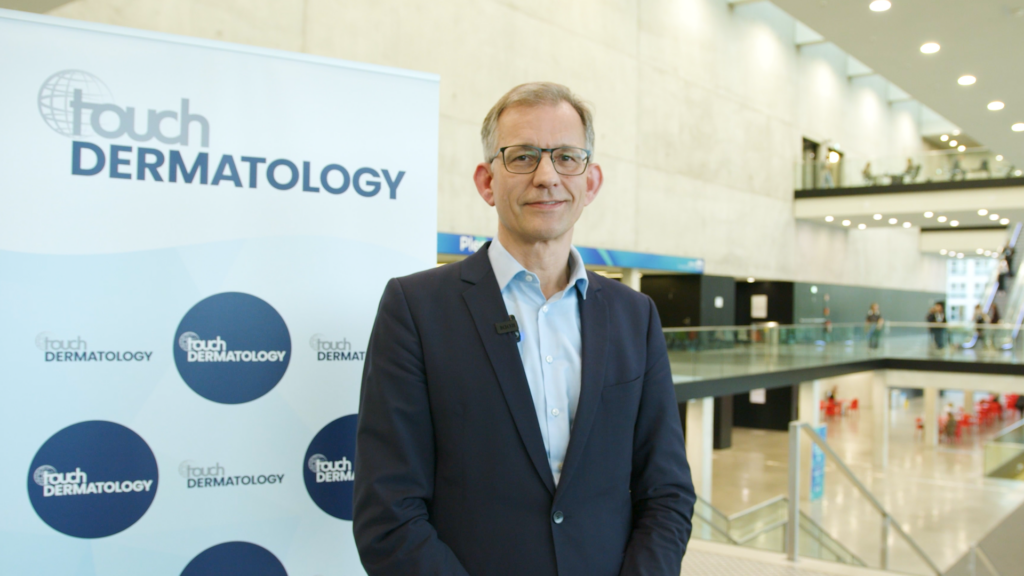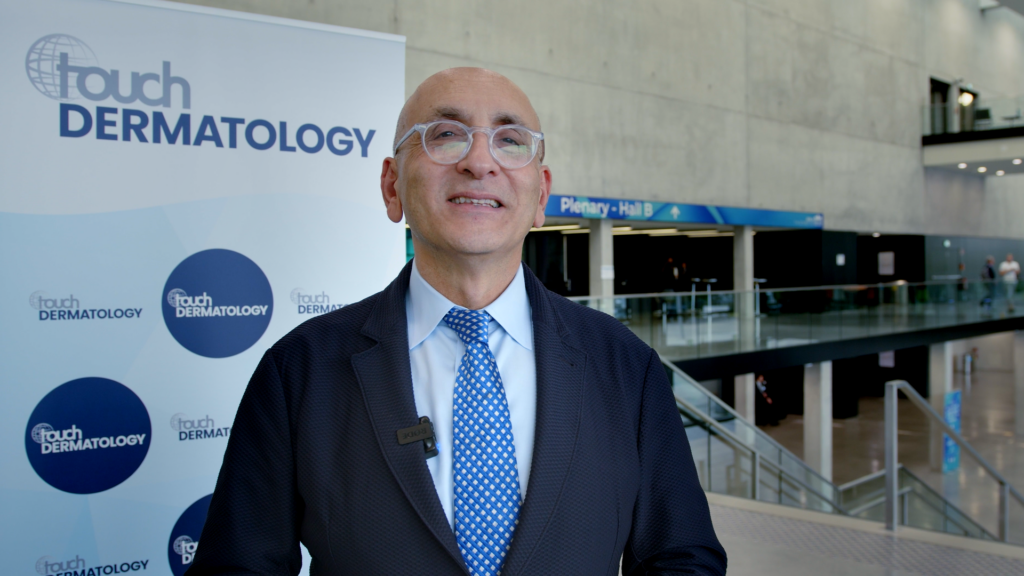TouchDERMATOLOGY coverage from AAD 2023:
Personalised medicine utilises biomarkers to predict patient outcomes and responses to treatment, ensuring that patients get the most effective treatment quicker. We were delighted to speak to Expert Faculty member Dr. William Damsky (Yale School of Medicine, New Haven, CT, USA) around the recent advances made in biomarkers and targeted therapies for inflammatory skin diseases, how a personalised approach will improve patient outcomes and quality-of-life and the future of personalised medicine in dermatology.
The abstract ‘Personalized medicine approaches to select the best treatment for patients with inflammatory skin diseases.’ was presented at AAD 2023, 17-21 March, 2023.
This content has been developed independently by Touch Medical Media for touchDERMATOLOGY & touchIMMUNOLOGY. It is not affiliated with, or endorsed by, the American Academy of Dermatology (AAD). Unapproved products or unapproved uses of approved products may be discussed by the faculty; these situations may reflect the approval status in one or more jurisdictions. No endorsement of unapproved products or unapproved uses is either made or implied by mention of these products or uses by Touch Medical Media or any sponsor. Views expressed are the speaker’s own and do not necessarily reflect the views of Touch Medical Media.
Questions
- What recent advances have been made in biomarkers and targeted therapies for inflammatory skin diseases? (0:13)
- How will a personalised approach to treatment improve patient outcomes and quality-of-life? (3:06)
- What do you consider the future direction of personalised medicine in dermatology? (4:12)
Disclosures: William Damsky discloses consulting for: Pfizer, Incyte, Eli Lilly, TWI Biotechnology, Fresenius Kabi, Epiarx Diagnostics, and Boehringer Ingelheim; receiving grant/research support from: Pfizer, Advanced Cell Diagnostics/Bio-Techne, AbbVie, Bristol Myers Squibb, and Incyte; and receiving licensing fees from: EMD/Millipore/Sigma.
Support: Interview and filming supported by Touch Medical Media Ltd. Interview conducted by Victoria Jones.
Filmed in coverage of the 2023 AAD Annual Meeting.
Click here for more content on dermatological conditions.
Transcript
What recent advances have been made in biomarkers and targeted therapies for inflammatory skin diseases? (0:13)
So people are really starting to think about this, which is exciting and so we’ve done some work in this area and there’s others that have done work in this area and so really the idea is what approach can be used to, you know, again, bridge this gap? How do we really decipher the immunology of any individual patient to pick the best therapy for them right out of the gate? And so what our group has employed is a cytokine staining approach and so we use an RNA in situ hybridization strategy, and we selected that because it’s very specific and appears to work very well and really rationally asking the question, what is the predominant cytokine or group of cytokines that’s expressed in a skin disease? So, we recently published a paper which is in the JAAD in atopic dermatitis and we said, you know what proportion of patients express in their atopic dermatitis only IL-13 or IL-4 and what percentage of patients also express other cytokines in addition, like interferon gamma, like a type 1 immune response or IL-17, a type 3 immune response. And what we found is that patients and this is a cohort of patients treated with dupilumab, which blocks the IL-4 receptor alpha, so it inhibits IL-4 and IL-13, we asked what percent or what were the cytokine profiles like in patients that responded well versus suboptimal lead to dupilumab? What we found is that the patients with the best responses to dupilumab expressed more sort of a pure IL-4 IL-13 profile which is targeted by the drug. In those patients that didn’t do quite as well, expressed other noncanonical cytokines like interferon gamma and IL-17 and so to us that was a really exciting finding and sort of provided some proof of concept that this was a viable approach to, to sort of dissect the immunologic heterogeneity in atopic dermatitis, for example. But I think these principles can be applied to other inflammatory skin diseases. There’s a couple other companies that are interested in this so Mindera is a company that’s developed sort of this biomarker patch which looks at RNA expression in lesions of psoriasis, and now based on an algorithm they developed to recommend optimal therapy for patients. I know CAS Biosciences is interested in this as well, and they’re using curettage as a method to collect tissue for analysis. Others are looking at tape stripping. And so really, it’s an exciting time in this area because there’s a lot of people thinking about it and trying to decide the best way to do this.
How will a personalised approach to treatment improve patient outcomes and quality-of-life? (3:06)
So, I think really the advantage here and we’re not there yet, but the goal is that the patient ends up on optimal therapy right out of the gate. And so it’s not uncommon to have a patient with psoriasis, for example, that may be treated with a medication like a TNF alpha inhibitor or maybe, you know, an IL-12 -23 inhibitor that has sort of a suboptimal response, but a response and sometimes these patients remain on that therapy when there may be another medicine like an IL-23 specific inhibitor out there that might clear their skin. And so I think it really gives hopefully will give us the ability to just put the patient on the optimal drug right from the get go, which will make life easier for patients, but make life easier for staff in the office that are going through great efforts to get these medications covered for patients. And we’re really just generally improve the efficiency of treatment of these disorders.
What do you consider the future direction of personalised medicine in dermatology? (4:12)
I think the ability to stratify patients with a similar with the same diagnosis into different groups. So let’s take briefly the example of atopic dermatitis. We might think about grouping patients into IL-13, predominantly atopic dermatitis versus sort of mixed atopic dermatitis where there may be more IL-17 or IL-22 interferon gamma. And we may even move beyond, you know, sort of a morphologic diagnosis and think about diagnoses like IL-13 predominant papulosquamous payments disorder that may not fit into any sort of specific category, but where the immunology sort of dictates what the patient is likely to respond to. So I think the future is, you know, subclassifying patients with the same diagnosis into therapeutically relevant categories. So it’s an exciting time.
Subtitles and transcript are autogenerated.










